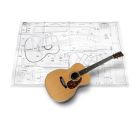Vicente Arias 1875 Classical Guitar Plan
In stock
SKU
PL-000-081
$37.50
Buy any 2 guitar plans get another free! - Just add any three plans of to your order and the discount will be applied in the shopping cart.
- Printed plan of a 1875 Vicente Arias Classical Guitar
- Based on full size classical guitar with 650mm scale length
- Accurately hand-drawn to full scale
- A0 size - 841mm x 1189mm (33" x 47")
- Shipped folded
- Includes bracing, thicknesses, materials list, fret positions & more
- Further details and restoration report below
Please note - Picture of guitar is for illustration purposes, plan is a black & white drawing
This full-scale printed plan of a Vicente Arias Classical Guitar was carefully hand-drawn by Australian luthier Ian Watchorn, who restored the instrument. It includes bracing layout and and profiles, thicknesses, neck profiles, fret positions, a materials list and more - everything you will need to reproduce the guitar.
The plan is not dimensioned, but it is accurately printed in full scale, so all measurements can be taken from it using a ruler or calipers.
Scroll down for further details and a report on the restoration of the guitar.






